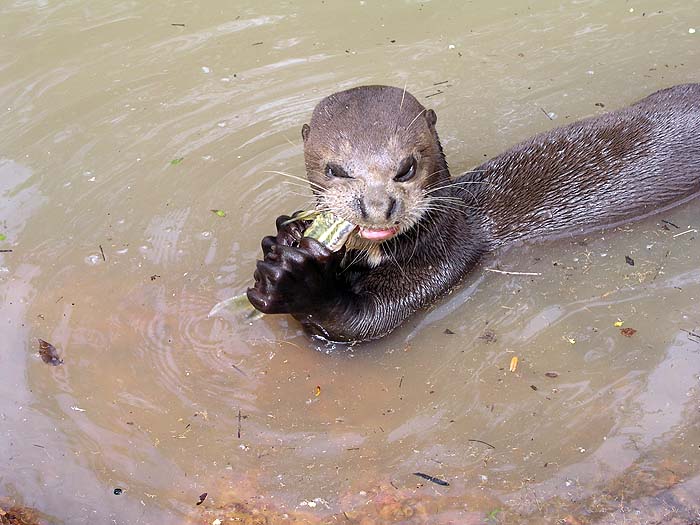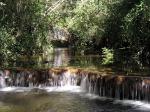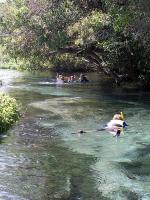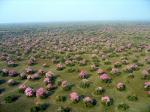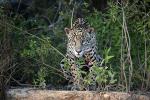So there I was snorkelling down a crystal-clear river through virgin forest, capuchin monkeys in the trees, shoals of coloured fish all around when suddenly the fish scatter as a giant river otter breaks the water to my right - wow!
Such is Bonito in southern Brazil, a picturesque area of forested hills, limestone caves and crystal-clear rivers and a world away from the steamy Amazon with its dark tannin-rich waters. Accessed from Campo Grande, Bonito is Brazil's adventure capital, a friendly tourist town in Mato Grosso do Sul, that fills in the summer with local holiday makers looking to reconnect with nature. Accommodation, granted, is very Brazilian with family run pousadas lining the high street coupled with several larger resorts but I did like the Ohlo d'Agua surrounded by pretty gardens and the Santa Esmeralda, a tranquil retreat in the surrounding countyside.
The highlight of Bonito is without doubt the freshwater snorkelling as I mentioned above, a truly magical experience, though other excursions include the Gruta do Lago Azul, an impressive glowing blue lake at the heart of a limestone cave; the Parque das Cachoeiras, a pretty area with a series of impressive waterfalls, and rafting down the Rio Formosa. Out of season, the town is quiet, the rivers empty and the adventure more unique - I really enjoyed it. High season and bank holidays, however, are a different prospect where the sheer numbers of holiday-makers turn the area into a eco-funpark where you find yourself on a conveyor belt being led from one busy, packaged excursion to another.
From Bonito, I was driven 2½ hours to the agricultural centre of Aquidauana on the edge of the Pantanal, Brazil's vast seasonal wetlands and one of the richest eco-systems on the planet. Having visited both the Iberá wetlands in northern Argentina and the Llanos in Venezuela, I was very keen to see how the Pantanal compared. From Aquidauana, I took a 30 minute hopper flight deep into the wetlands to visit a number of remote lodges basing myself at Embiara Lodge [now closed, try Aguape instead]. Set within 2,000 hectares of land comprising of forest, savanna and river, Embiara is the most comfortable lodge in the area offering an African safari style experience. Surrounded by trees with paths leading off to the nearby river and pasture lands, the wildlife was stunning. Within the space of my very first afternoon, I saw capybara, armadillos, rhea, marsh deer, wild pigs and peccaries not to mention the countless species of birds nor the resident hyacinth macaws and curassow that flutter around the lodge itself.
The food was excellent, the guiding and level of service first class and each evening we gathered in the main lodge to look at the images of the resident puma taken by the camera-traps - placed in forest very close to my room I hasten to add! From Embiara, I also managed to visit Barra Mansa and Barranco Alto, two other lodges located along the same river. With over 10,000 hectares of land, Barranco Alto is a good deal larger than Embiara and as a working farm offers not just a similar abundance of wildlife but also more of the traditional Pantanal cowboy culture. Barra Mansa on the other hand, is smaller, run by a charming family and very close to a series of shallow drainage fields which fill during the wet season. In fact one of my personal highlights was taking a boat across these marshes enjoying the amazing wildlife below and above the water and photographing the rippled reflections of the sky on the water, stunning!
All three lodges complement each other nicely and more importantly are beginning to work together in receiving guests which is one of the key issues they have. Private planes are expensive unless you can fill them while the overland transfer to Campo Grande, the nearest airport with scheduled flights, takes 5-6 hours in the dry season and is often impassable after the rains. For this reason, they often lose out to the northern Pantanal or to lodges on the edge of the southern Pantanal closer to the airport. Pousada Aguapé, for instance, is only 2-3 hours from Campo Grande and though surrounded by pasture land rather than the the wilder mix of forest and savanna offers an excellent blend of wildlife and traditional pantaneira culture.
Bonito and the Southern Pantanal are a natural combination, adventure plus wildlife, and work especially well for families. They also tie in nicely with Iguassu Falls and the Atlantic rainforest and picturesque island of Ihla do Mel close to Curitiba, a trip which would offer an incredible array of landscapes, experiences and wildlife all within a small(ish!) corner of Brazil.

